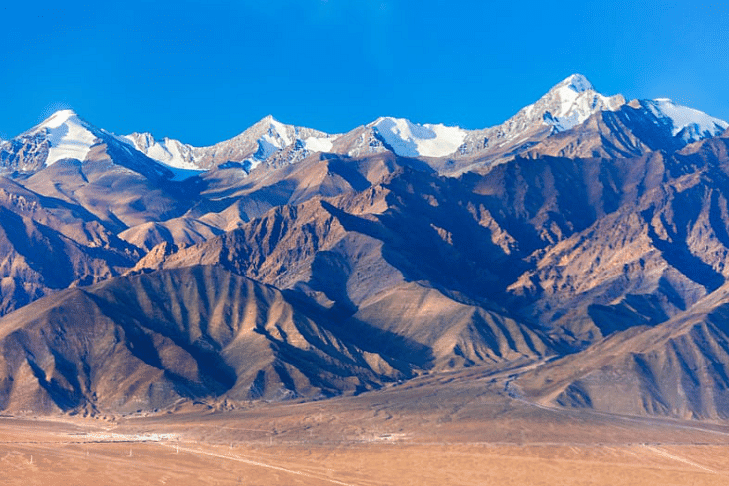The Northern Mountains Chapter Notes - Class 4 PDF Download
| Table of contents |

|
| The Himalayan Ranges |

|
| Importance of High Peaks and Glaciers |

|
| Ladakh |

|
| Himachal Pradesh |

|
| Uttarakhand |

|
| Sikkim |

|
| Purvachal Hill Ranges |

|
| Historical Significance |

|
The Himalayan Ranges
The Himalayas span from Jammu & Kashmir to Arunachal Pradesh, featuring the highest peak, Mount Everest, located on the Nepal-China border. The Himalayas consist of three parallel ranges:
- The Greater Himalaya (Himadri)
- The Middle Himalaya (Himachal)
- The Outer Himalaya (Shiwalik)
 The Great Himalayas
The Great Himalayas
These towering peaks are often snow-covered throughout the year, presenting a challenge for mountaineers while offering breathtaking views.
- In 1953, Tenzing Norgay from India and Edmund Hillary from New Zealand achieved the remarkable feat of summiting Everest, proudly planting the Indian flag at the peak.
 Tenzing Norgay- India
Tenzing Norgay- India
- Bachendri Pal, the first Indian woman to conquer Everest in 1984, paved the way for subsequent successful expeditions.
 Bachendri Pal- India
Bachendri Pal- India
Importance of High Peaks and Glaciers
- Glaciers from high peaks feed rivers like Ganga, Yamuna, Satluj, and Brahmaputra, ensuring water availability during summer.
- Himachal ranges have hill resorts like Srinagar, Nainital, Mussoorie, Dalhousie, and Darjeeling, attracting tourists.
- Valleys between hills are suitable for farming (apples, pears, plums, potatoes) and provide valuable forest resources (pine, deodar).
Life in the Region
- Farming is the primary occupation due to the lack of plain land, leading to terrace farming for crops like rice, maize, barley, and potatoes.
- Sheep rearing and wood carving are also common activities in the mountains.
Ladakh
- Ladakh is known for its unique landscape, clothing traditions, and attractions like the Zanskar Valley and Pangong Lake.
- Men wear goncha, a thick woollen robe, while women wear kuntop along with colorful shawls.
 Ladakh
Ladakh
Himachal Pradesh
- Himachal Pradesh is famous for its apple orchards and cultural elements like Kullu caps and dhazu scarves.
- The Kullu Dussehra festival is a significant event attracting many tourists.
 Himachal Pardesh
Himachal Pardesh
Uttarakhand
- Known for basmati rice, lychees, and plums, Uttarakhand also offers attractions like Mussoorie, Nainital, and Haridwar.
- Local artisans weave woollen shawls, scarves, and rugs as part of their traditional crafts.
 Uttarakhand
Uttarakhand
Sikkim
- Sikkim is renowned for its produce like oranges, cardamom, and orchids, along with unique attire and jewelry traditions.
- Gangtok and Pelling are among the key tourist destinations in Sikkim.
 Sikkim
Sikkim
Purvachal Hill Ranges
- The Purvachal Hill Ranges in the northeast, also known as the North-Eastern Hills, are characterized by dense forests and agricultural practices.
- States like Arunachal Pradesh, Nagaland, Manipur, Mizoram, Tripura, and Meghalaya are part of this region, focusing on farming, weaving, and fruit cultivation.
 Purvanchal Hills
Purvanchal Hills
Historical Significance
- Khyber Pass: This pass is historically significant as it has been used as a strategic route for invasions and trade for centuries. One notable event was Alexander the Great's invasion of India in 327 B.C. Alexander's army crossed the Khyber Pass as part of their campaign into the Indian subcontinent. The pass connects Afghanistan to what is now Pakistan and has been a key route for military movements and commerce between Central Asia and the Indian subcontinent.
- Nathula Pass: Located in the eastern part of the Himalayas, Nathula Pass has also seen historical significance, especially during modern times. In 1962, during the Sino-Indian War, Chinese forces used Nathula Pass to enter Indian territory in Sikkim. This event marked a significant military engagement in the region and highlighted the strategic importance of mountain passes in border security and defense.
- These passes facilitated significant events, such as Alexander's invasion in 327 B.C. and Chinese forces' movement in 1962.
Key Facts to Remember
- The Himalayas are renowned for their grandeur and strategic importance, spanning multiple regions and countries.
- Notable achievements include Mount Everest as the highest peak, Tenzing Norgay's and Bachendri Pal's historic climbs, and the ecological benefits the Himalayas provide.
- Conservation efforts are crucial to safeguard the Himalayan forests, wildlife, and the invaluable resources they offer.
FAQs on The Northern Mountains Chapter Notes - Class 4
| 1. What is the importance of high peaks and glaciers in the Himalayan Ranges? |  |
| 2. Which states in India are home to the Himalayan Ranges? |  |
| 3. What is the historical significance of the Northern Mountains? |  |
| 4. How do the Himalayan Ranges impact the climate of the surrounding regions? |  |
| 5. What are some popular tourist destinations in the Himalayan Ranges? |  |

|
Explore Courses for Class 4 exam
|

|

















